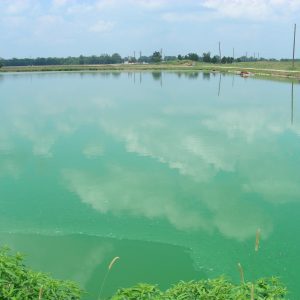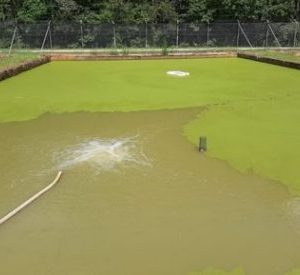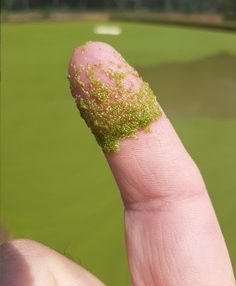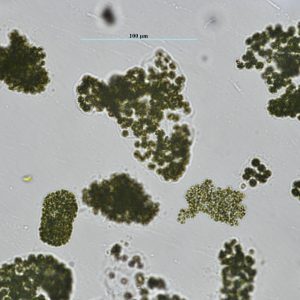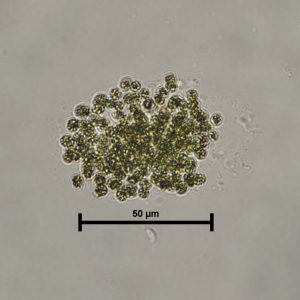Aquaculture

Blue-green algae, also known as cyanobacteria, are microscopic organisms frequently found in aquaculture ponds in the southeastern United States.
Although blue-green algae are common in freshwater systems, blooms (dense accumulations of these organisms) can lead to serious issues for catfish farmers. Some, but not all, blue-green algae can produce compounds that are toxic to catfish or may lead to unwanted taste and odors in fish fillets. Bloom formations may also create low oxygen conditions at night or as cells decay following a crash in a bloom. Of the blue-green algal species in the southeast, Microcystis is among the most common and often leads to problems for catfish farmers.
Microcystis blooms often form distinctive Kelly green scums at the water surface (figure 1). Many other kinds of blue-green algae, other kinds of algae, and aquatic plants (such as duckweed or watermeal) form surface blooms or mats during certain times of the year that are army green or various other shades (figures 2a and 2b). So, more formal identification of the algae is needed. Microcystis can be identified using a microscope and is typically distinguishable as groups of small, circular cells (colonies) within a jelly-like mass (figures 3a and b). Your county Extension agent can assist in identification, if needed.
As with other blue-green algae, Microcystis blooms can lead to very high or low oxygen conditions and the production of high concentrations of toxins or off-flavor compounds. It is important to note that not all blue- green or other algae in a farm pond are bad, as they can help facilitate oxygen production and form the base of the food web. Due to their potential negative impacts on ponds, however, a great deal of research has been conducted to understand how and why Microcystis blooms form, their effect on farm-raised fish, and methods to control blooms when they occur.
- Figure 1. A substantial Microcystis bloom.
- Figure 2a. Watermeal floating on top of a pond.
- Figure 2b. Individual plants that make up the floating mass.
- Figure 3. (a and b) Microcystis colonies (circular cells panels a and b) often found floating on water surface.
- Figure 3. (a and b) Microcystis colonies (circular cells panels a and b) often found floating on water surface.
What Causes a Microcystis Bloom?
The conditions ideal for Microcystis and other blue- green algal blooms include, but are not limited to, warm water temperatures, ample sunlight, high nutrient concentrations (particularly phosphorus and nitrogen), or a combination of these factors. Water temperatures greater than 77 degrees F are thought to be preferable for a bloom. Nitrogen and phosphorus are typically already abundant in aquaculture ponds due to regular feeding of farmed fish but may also enter a pond via runoff (such as waste from nearby livestock). In Alabama, such conditions typically occur midspring through late fall with the increase in daylight hours. As peak feeding season for catfish farmers in Alabama occurs in the early spring and summer months, the high nutrient inputs and warmer temperatures lead to conditions that favor blooms.
The conditions favorable for a Microcystis bloom are also ideal for a wide range of other blue-green algae and other algae species, yet Microcystis blooms commonly dominate these other species in southeastern ponds. One major advantage thought to assist Microcystis species include their ability to float on the water surface. This buoyancy allows Microcystis colonies greater access to sunlight to increase their growth. Microcystis can also move freely between different depths to obtain nutrients sometimes present at the bottom of the pond. The sticky nature of Microcystis colonies
and their potential toxicity also serve as protection against organisms that might otherwise eat them, which may help Microcystis dominate other algal species in southeastern ponds.
Microcystis Toxicity
Select types of Microcystis can produce a variety of compounds, such as microcystin, that can be toxic to fish, livestock, pets, and humans. In catfish, microcystin enters the body through the gills or intestines (accidental ingestion) affecting these organs as well as the liver and kidneys. Large catfish die-offs due to microcystin have been documented but are infrequent. Although fish die-offs do not always occur, a catfish affected by microcystin may exhibit reduced growth and feeding and increased stress, ultimately reducing farm profits.
It must be stressed that not all blue-green algae, or even all Microcystis species, produce harmful compounds, and toxin- and nontoxin-producing kinds of blue-green algae can be in the same pond simultaneously. To further complicate things, toxin-producing blue-green algae do not always produce the same amount of toxins, so every bloom is different. Unfortunately, there is no easy way to determine if a particular Microcystis bloom will be toxic or not. While laboratory and pond-bank tests are available to determine if a toxin, such as microcystin, is present, extensive training and equipment are needed to assess toxicity. Contact your Extension agent to help find a laboratory that can perform these tests.
Stopping a Microcystis Bloom
There are many ways to control Microcystis blooms, including the use of chemical, physical, and biological controls. Chemical controls, or algicides, nutrient reduction, physical controls, such as aerators, and biological controls, such as zooplankton and small fish, are typically used in pond aquaculture.
Chemical Controls
Copper compounds such as copper sulfate and chelated copper complexes have been effectively used to treat blooms in commercial catfish ponds, and copper sulfate is an Environmental Protection Agency (EPA)-approved algicide for use in food-fish aquaculture. Numerous studies of copper-based algicides have shown their effectiveness. Multiple copper treatments may be needed, however, to keep a bloom at bay, as copper is a relatively heavy metal and will settle to the pond bottom over time. In addition, copper can be toxic to catfish if the pond alkalinity is less than 50 milligrams per liter. Commercial catfish producers must perform an alkalinity check before treating with copper to confirm that the alkalinity is high enough to avoid potential fish toxicity issues.
As is the case with many algicides, copper kills many kinds of aquatic plants. A heavy treatment of copper may rapidly lead to the threat of low oxygen conditions if oxygen-producing algae are killed. Oxygen will continue to drop as decomposition takes place. Manufacturer- recommended dosage guidelines must be followed to avoid severe problems.
In addition to lack of oxygen, algicide applications may cause blue-green algal toxins to be released in the water during the decomposition process. Since toxins can be degraded naturally over time, smaller doses of an algicide can help reduce a pulse of toxins into a pond potentially caused by one large dose.
Numerous other algicides for removing blue-green algae blooms have been tested but have regulatory limitations for use in catfish aquaculture. For example, Diuron is a urea-based herbicide used in land-based agriculture and is also effective against algal blooms in ponds. Its use in agriculture has made the toxicity of Diuron well-studied, and low doses are relatively nontoxic to fish. Diuron with a 24 (c) label is EPA-approved for use in aquaculture to prevent blue-green-algae-induced off-flavor issues and can be used to reduce Microcystis blooms if they are found to be the cause of the off-flavor. Unlike copper sulfate, however, Diuron’s 24 (c) label must be reapproved yearly. Contact your Extension agent to determine if a treatment of Diuron is recommended for a pond where fish are found to be off-flavor.
In addition to Diuron, sodium carbonate peroxyhydrate, a granular chemical that emits hydrogen peroxide as its active algicidal ingredient, has EPA approval as an aquatic algicide, but it is not labeled for use in food- fish production systems. Additional chemicals and/or compounds, such as clay compounds, liquid hydrogen peroxide, and peracetic acid, have also shown promise against blue-green algal blooms but are not currently approved for use in food-fish aquaculture.
Nutrient Reduction
Ultimately, reducing nutrients, specifically nitrogen and phosphorus, entering a pond is a necessary step to preventing Microcystis blooms. However, this is difficult to accomplish in commercial aquaculture ponds. Commercial catfish producers may feed at rates that exceed 150 pounds per acre per day during peak feeding months resulting in the introduction of large amounts of nutrients into a pond. Nutrients may also come from run-off. Preventing overfeeding through appropriate feed-management techniques and minimizing run-off can help reduce bloom severity and duration. Unfortunately, how much nitrogen and/or phosphorus blue-green algae need to form a bloom can vary from pond to pond, so there is no simple answer as to what nutrient type should be removed. This variability, and the required addition of nutrients into a pond in the form of feed, makes nutrient-reduction tactics difficult but can play an important role in bloom reduction over time when combined with other control types.
Physical Controls
Many physical controls are costly, require equipment, and sometimes require changing the layout of a pond. One relativity low-cost physical control is mechanical mixing performed by aerators or water circulators. Since Microcystis blooms typically exist as a surface scum, surface water can prevent scums from eventually taking over the entire surface of the pond. An added benefit is that mechanical mixing increases turbidity, which in some cases helps reduce blooms. Added turbidity may, however, increase the amount of nutrients in the water column as well, possibly leading to more severe blooms. Contact your Extension agent to help determine whether mixing can prevent Microcystis bloom issues in a given pond.
Biological Controls
Biological controls are methods for removing an unwanted organism, in this case, blue-green algae, using another organism or pathogen. One biological control method shown to have potential against blue- green algae in farm ponds is using zooplankton to manipulate the pond food web as zooplankton are natural consumers of blue-green algae and other algal species. Zooplankton are naturally occurring small, often microscopic, organisms that inhabit ponds and are efficient algae eaters. Some zooplankton have been shown to gain the ability to tolerate eating toxic blue- green algae over time.
A typical food web manipulation in a pond would involve removing fish, such as shad or sunfish, which are predators of zooplankton. Under the correct conditions, removing small fish could allow populations of large- bodied zooplankton to thrive and then reduce the amount of algae, including blue-green algae. While successful under research conditions, food web manipulations are still being tested at the commercial level. These manipulations require close monitoring and accounting for other factors that may make this control type ineffective, particularly due to excessive nutrient inputs and introducing small fish from unknown sources. Removing small, scaly fish on commercial catfish farms is also difficult considering that these fish are often accidentally stocked with catfish. Moreover, severe and preestablished Microcystis blooms may be out of the control of zooplankton grazing.
The addition of small fish, such as shad, into a pond has also been used as a biological control for removing blue- green algae. Small fish limit the amount of blue-green algae in some situations, but the documented success of this control tactic has varied. Small fish may also eat zooplankton, as previously stated. When zooplankton are removed, a pond may experience an increase in blue-green algae. In summary, increasing both the number of small fish or zooplankton as a biological control in a pond has had varying success and may be useful to catfish farmers in certain situations. As such, this control type should be considered on a case-by- case basis.
Conclusions
Microcystis blooms can be a major problem in the catfish aquaculture industry by creating low oxygen conditions as blooms die and through the production of the toxin, microcystin, which is harmful and sometimes lethal to catfish. Because commercial catfish ponds typically contain large amounts of nutrients and are in climates that experience prolonged warm weather, they are ideal conditions for bloom events. Treating blue- green algal blooms often involves chemical or physical controls, although biological control types do exist and may be useful under certain conditions. It should be noted that not all Microcystis blooms will produce toxins and treating a bloom because of concerns of toxicity may not be necessary. If you are experiencing a bloom event in your ponds, contact an Extension agent to help you identify the correct controls to use, connect you
to labs to determine if a bloom is toxic, and help you develop an effective control plan. If you believe you may have issues related to Microcystis blooms, contact the Alabama Fish Farming Center in Greensboro, Alabama.
Additional Reading
- Paerl, H.W., Fulton III, R.S., Moisander, P.H., and Dyble, J. 2001. Harmful freshwater algal blooms, with an emphasis on cyanobacteria. The Scientific World Journal. 1:76-113.
- Paerl, H.W., and Huisman, J. 2008. Blooms like it hot. Science. 320(5872):57-58.
- Malbrouck, C., and Kestemont, P. 2006. Effects of microcystins on fish. Environmental Toxicology and Chemistry. 25(1):72-86.
- Zimba, P.V., Khoo, L., Gaunt, P.S., Brittain, S., and Carmichael, W.W. 2001. Confirmation of catfish, Ictalurus punctatus (Rafinesque), mortality from Microcystis toxins. Journal of Fish Disease. 24(1):41-47.
- Schrader, K.K., Tucker, C.S., Hanson, T.R., Gerard, P.D., Kingsbury, S.K., and Rimando, A.M. 2011. Management of musty off-flavor in channel catfish from commercial ponds with weekly applications of copper sulfate. North American Journal of Aquaculture. 67(2):138-147.
- Harke, M.J., Steffen, M.M., Gobler, C.J., Otten, T.G., Wilhelm, S.W., Wood, S.A., and Paerl, H.W. 2016. A review of the global ecology, genomics, and biogeography of the toxic cyanobacterium, Microcystis spp. Harmful Algae. 54:4-20.
- Kelly, A.M., Roy, L.A. 2021. The use of diuron to control off-flavor in Alabama catfish production ponds. Alabama Cooperative Extension Fact Sheet. ANR-2744. 2pp.
- Chislock, M. F., Sarnelle, O., Olsen, B. K., Doster, E., and Wilson, A.E. 2013. Large effects of consumer offense on ecosystem structure and function. Ecology. 94(11):2375-2380.
 Riley Buley, Graduate Research Assistant, Anita Kelly, Extension Professor, Luke Roy, Associate Extension Professor, Edna Fernandez-Figueroa, Graduate Research Assistant, Matthew Gladfelter, Graduate Research Assistant, Angelea Belfiore, Graduate Research Assistant, and Alan Wilson, Professor, all in Fisheries, Aquaculture, and Aquatic Sciences, Auburn University
Riley Buley, Graduate Research Assistant, Anita Kelly, Extension Professor, Luke Roy, Associate Extension Professor, Edna Fernandez-Figueroa, Graduate Research Assistant, Matthew Gladfelter, Graduate Research Assistant, Angelea Belfiore, Graduate Research Assistant, and Alan Wilson, Professor, all in Fisheries, Aquaculture, and Aquatic Sciences, Auburn University
New August 2021, Controlling Microcystis Blooms in Alabama Catfish Aquaculture, ANR-2757


